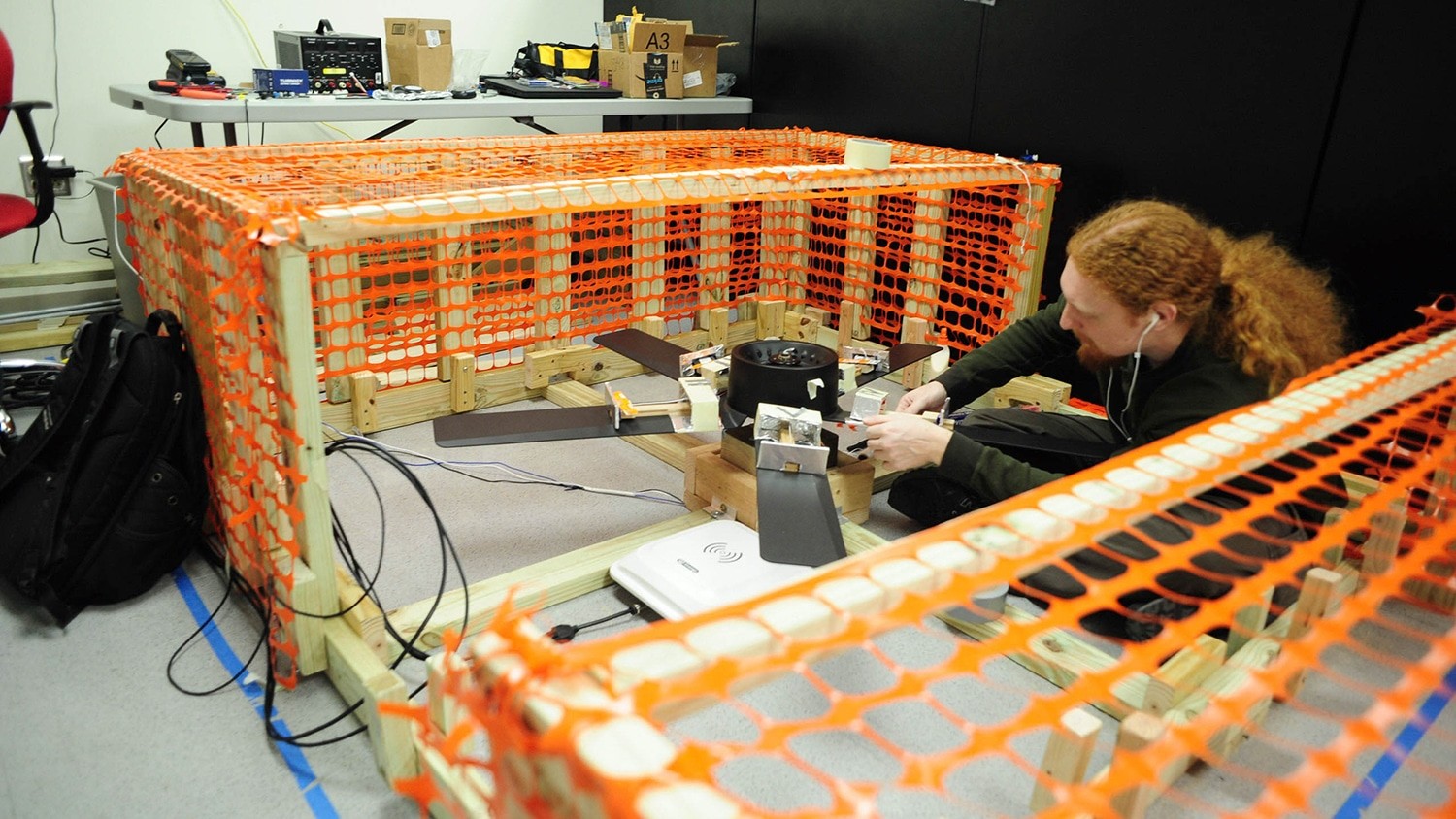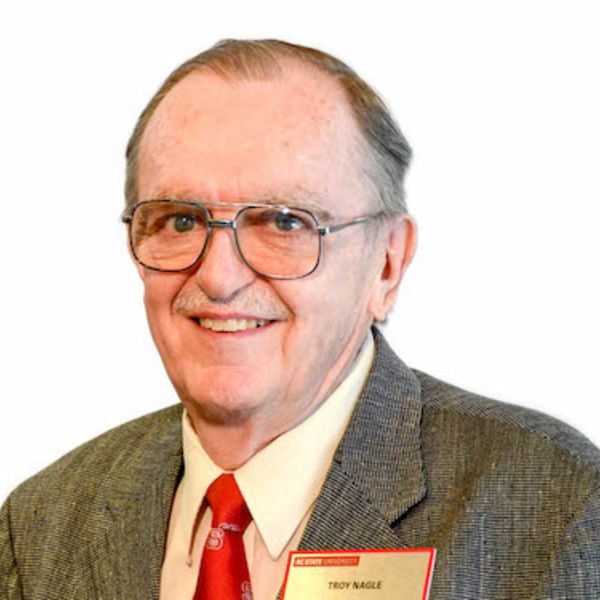
Capstone Projects: Better by design
Senior design in the College of Engineering benefits both students and sponsors.
July 6, 2019 ![]() Staff
Staff
On December 7, 2018, seniors in the Edward P. Fitts Department of Industrial and Systems Engineering (ISE) and the Department of Electrical and Computer Engineering (ECE) held their end-of-semester senior design exhibitions at the McKimmon Conference and Training Center on NC State’s campus.
In each department’s exhibition room, rows of tables displayed intriguing project posters and prototypes of designs intended to solve real-world problems, such as a simulation model to help mitigate high wait times for patients at the Durham VA Prime Clinic and an in-flight system to alert helicopter pilots to damaged blades.
This was their day – the day ISE and ECE seniors got to demonstrate their engineering design chops.
All engineering departments at NC State have capstone design courses for their seniors with variations among course length — one semester or two — and program size. Most, but not all, are sponsored projects.
Bobby Compton is the director of ECE’s Senior Design course. ECE’s design program is one of the largest senior design programs in the College.
“We have 200 students in any one semester involved in senior design across four class sections,” he said.
Compton and Dr. Rachana Gupta, teaching associate professor and associate director of ECE Senior Design, teach the two senior design capstone courses, ECE 484 and 485. Each course is one semester long, but students begin their design project in ECE 484 and complete it in ECE 485.
“The students go from the prototype in the first course to full-scale implementation in the second,” said Stacy Nelson, an ECE lecturer who provides instructional support and is responsible for the logistics of ECE Design Day.
According to Nelson, ECE 484 ends with the product requirements fleshed out and a prototype made. Seniors in ECE 485 continue the project but focus on budgeting, project management, marketing and project presentation. Students in both courses make end-of-semester presentations on Senior Design Day.
Dr. Kanton T. Reynolds (IE ’95), teaching associate professor and director of ISE’s undergraduate programs, runs ISE’s senior design program. The department’s Engineering Design Day is the result of work completed in capstone courses ISE 498 and ISE 521. ISE 498 is one semester long. Reynolds and lecturer Jason Low typically co-teach ISE 498, depending on how many students are part of the course. This spring, associate professor Dr. Rohan Shirwaiker was added. Also in the spring, health systems capstone course ISE 521 is held, which is taught by Dr. Julie Ivy. Students spend a year on the ISE 521 projects.
Benefits to students
Reynolds knows that senior design provides significant benefits to students.
“It allows the students to take the knowledge they’ve accumulated over their academic career at NC State and punctuate it with a course that encapsulates all of the opportunities that they may have to display that knowledge,” he said.
Reynolds adds that the students get to work in a team on a long-standing project and deliver it to a customer while demonstrating they are worthy of working for that company.
Early on, Reynolds makes sure that the students have the skills needed to meet the sponsors’ needs. Students are assigned to project teams as soon as the second day of class.
Kurtis Konrad, who graduated in December with degrees in industrial engineering and economics, was teamed with Trevor Bryant, Adam Dorr and Stephanie Stugg. They worked for HSM Solutions, a furniture manufacturing company in Hickory, NC, developing an inventory tracking and performance management system.
Konrad said that senior design projects provide an excellent experience for students as they prepare to join the work force: “(Senior design) allows you to work on a team and gives you the guarantee of working on a specific project. You follow an entire project from start to some sort of finishing point, so you get to see all of the steps involved,” he said.
Benefits to sponsors
Both programs rely on various means of recruiting sponsors.
“We actively meet and engage with companies and research centers throughout the year to harvest projects,” Compton said.
ECE Senior Design has a number of repeat sponsors including the Army Research Office, Duke Energy, NAVAIR, Pentair and Schneider Electric.
Trudi Brown, ECE director of external relations, said that sponsors like to work with the senior design teams. “What sets our students apart is our in-depth program, and when you talk to external people that have been involved with the program, they will tell you how pleased they are with the students’ knowledge and approach to problem-solving.”
ISE recruits many of its sponsors through cold calls and the Engineering Career Fair. When Reynolds recruits company sponsors, he’ll tell them, “It’s try before you buy … You’re getting a group of three to five students working for you exclusively for an entire semester and you get to take them for a test drive. You get to see them work with your staff, each other and with external partners.”
He further points out that senior design teams provide dedicated resources to work on a problem, resources the company may not have. For example, Toshiba makes point-of-sale systems and was looking to understand the shopping and buying patterns of “twenty-somethings.” Toshiba used an ISE senior project team to design an optimal self-checkout for a shopper in the team’s age demographic.
Among its many repeat sponsors, ISE has a group of strong company and industry supporters of senior design including IBM, Tyndall, Caterpillar and Altec.
Juli Trexler (ISE ‘97) is global executive and director of IBM Support as a Service Business Line. She serves on ISE’s advisory board, has served as an Engineering Design Day judge and has sponsored several senior design projects, including one last semester. Team members Rodrigo Cabrera, Shadia Garrison, Matt Hutmacher and Rachel Nagley collaborated on a global project with all regions to create recommendations to reduce IBM’s parts delivery timeliness (PDT) reporting time and increase global consistency.
Trexler found the team to be very quick to “jump in, assess the project from a process standpoint and then make recommendations on a pretty complex operation.” She was pleased with their final recommendations.
Altec Industries, Inc., is a trucking equipment company in Creedmoor, NC. According to Scott Cunningham, plant manager, the company recently purchased a second facility next door. Altec wanted to move all fiberglass operations to the new building.
Senior design team members Rollin Jenkins, Spain Niemer and Mikayla Slomski came up with two ways of transporting parts between the two facilities, detailing the pros and cons of each. Cunningham said that the company plans to move forward with one of the concepts and that the manufacturing team enjoyed the experience. “It helped us. I hope it helped them to see some real-world challenges out there and apply what they learned in school … I felt that it was a win for us, it was a win for the students.”
There’s a consensus among faculty members, students and sponsors: Senior design projects make everyone a winner.
Return to contents or download the Spring/Summer 2019 NC State Engineering magazine (PDF, 13.7MB).


